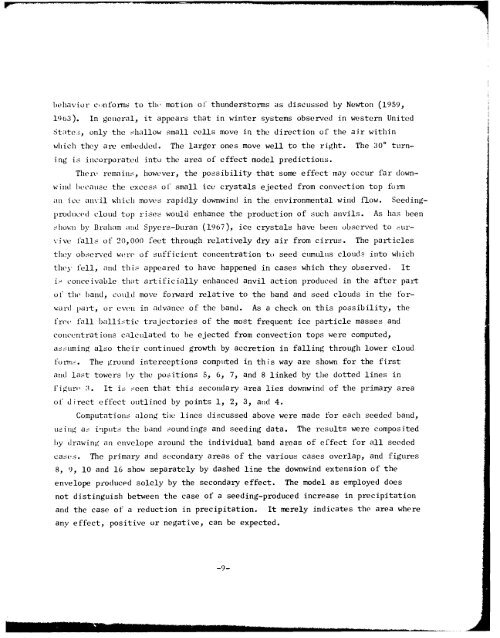pages - The Black Vault
pages - The Black Vault
pages - The Black Vault
- No tags were found...
You also want an ePaper? Increase the reach of your titles
YUMPU automatically turns print PDFs into web optimized ePapers that Google loves.
ehavior c,ýnforms to the motion of thunderstorms as discussed by Newton (1959,1963). In general, it appears that in winter systems observed in western UnitedStates, only the shallow small cells move in the direction of the air withinwhich they are embedded. <strong>The</strong> larger ones move well to the right. <strong>The</strong> 300 turningis incorporated into the area of effect model predictions.<strong>The</strong>re remains, however, the possibility that some effect may occur far downwindbecause the excess of small ice crystals ejected from convection top forman ice anvil which moves rapidly downwind in the environmental wind flow. Seedingproducedcloud top rises would enhance the production of such anvils. As has beenshown by Brahiam and Spyers-Duran (1967), ice crystals have been observed to zurvivefalls of 20,000 feet through relatively dry air from cirrus. <strong>The</strong> particlesthey observed were of sufficient concentration to seed cumulus cloud:- into whichthey fell, and this appeared to have happened in cases which they observed. Itis conceivable that artificially enhanced anvil action produced in the after partof the band, could move forward relative to the band and seed clouds in the forwardpart, or even in advance of the band. As a check on this possibility, thefree fall ballistic trajectories of the most frequent ice particle masses andconcentrations calculated to be ejected from convection tops were computed,assuming also their continued growth by accretion in falling through lower cloudforms. <strong>The</strong> ground interceptions computed in this way are shown for the firstand last towers by the positions 5, 6, 7, and 8 linked by the dotted lines inFigure, 3. It is seen that this secondary area lies downwind of the primary areaof direct effect outlined by points 1, 2, 3, and 4.Computations along thle lines discussed above were made for each seeded band,using as inlputs the band soundings and seeding data. <strong>The</strong> results were compositedby drawing an envelope around the individual band areas of effect for all seededcases. <strong>The</strong> primary and secondary areas of the various cases overlap, and figures8, 9, 10 and 16 show separately by dashed line the downwind extension of theenvelope produced solely by the secondary effect. <strong>The</strong> model as employed doesnot distinguish between the case of a seeding-produced increase in precipitationand the case of a reduction in precipitation. It merely indicates the area whereany effect, positive or negative, can be expected.-9-





![Combat Support in Korea [270 Pages] - The Black Vault](https://img.yumpu.com/49796461/1/190x71/combat-support-in-korea-270-pages-the-black-vault.jpg?quality=85)










